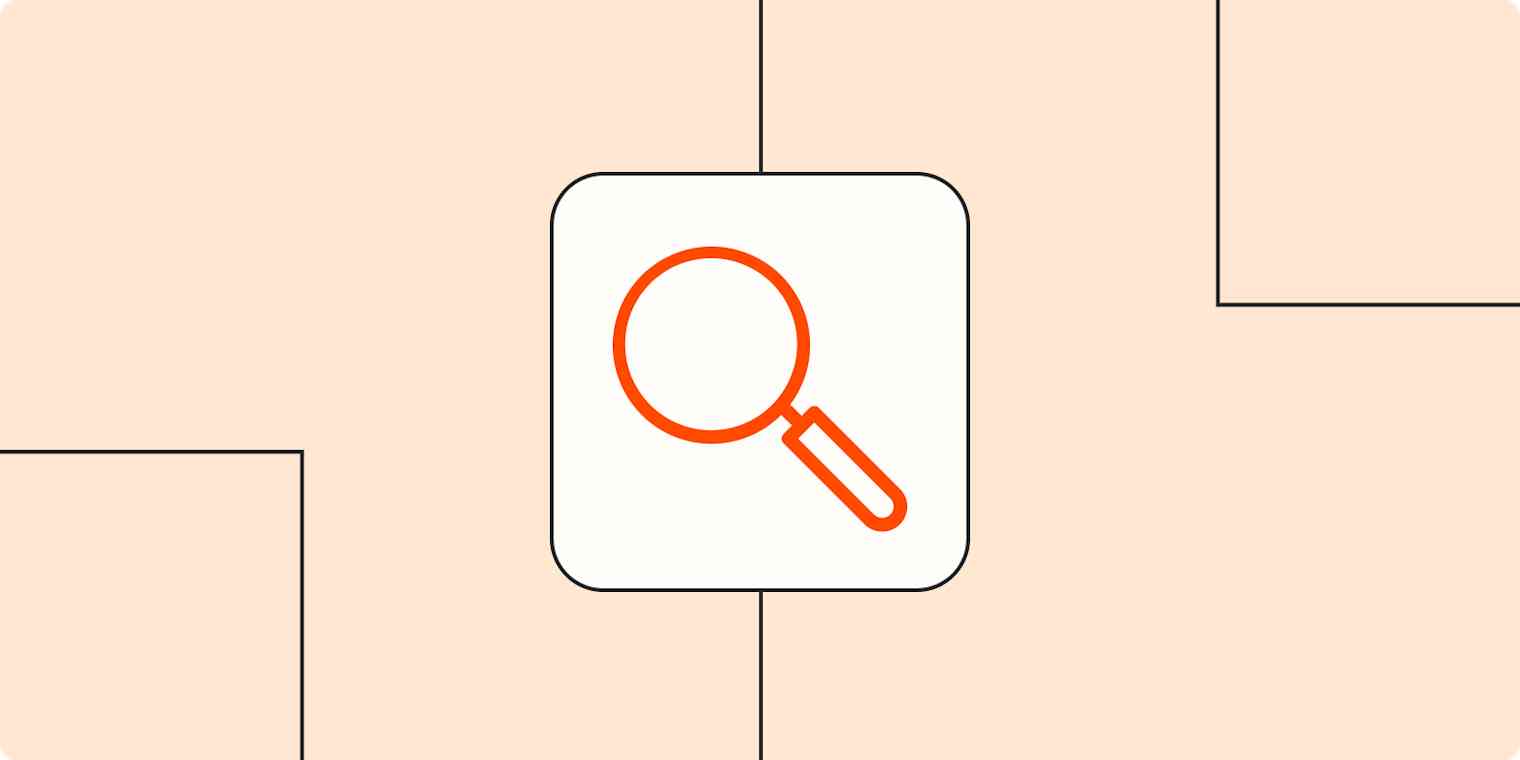As Google evolves its algorithm, it's becoming increasingly better at understanding what users are searching for when they look up queries like "making my house shine."
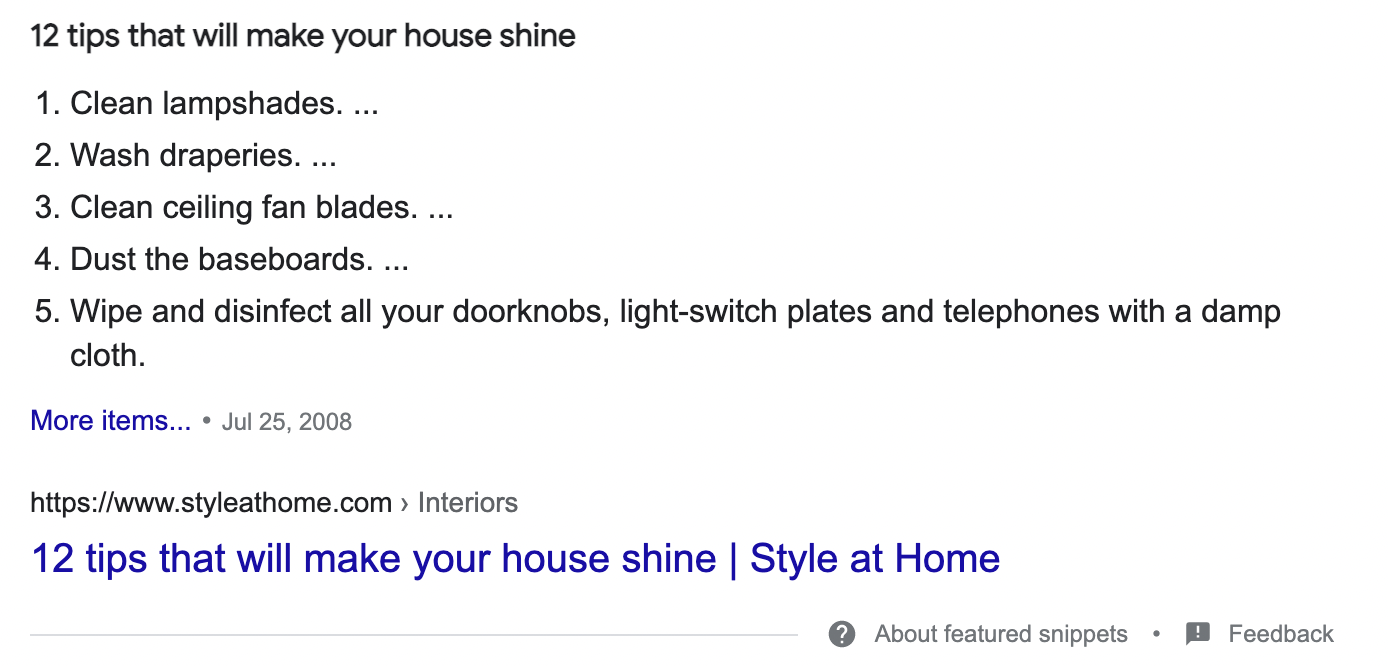
Google understands that the best result isn't wax for your floors but a list of steps for a deep clean.
When I started creating content nearly two decades ago, my thought process followed the same logic every time: what keywords with search volume are relevant to my business? Now, keywords don't cut it. In order to provide the most value for your audience, you need to consider the search intent behind what those potential customers are searching for.
I've spent a lot of time on this at Zogics, and our customers—and our business—are better off. So here, I'll show you a quick way to identify the search intent behind a query and how to use this information to optimize your content.
Types of search intent and how to identify them
You don't need to use your imagination to figure out user intent: you can just peek at the search engine result pages (SERPs) and see what's ranking. Google has done the work for us.
Here's what I mean: if Google places a page on the first spot, but everyone clicks on the third, Google will use this information to rearrange the SERP and place the most relevant content on top. So we just need to match a search to the top result(s), and we'll know what the intent of the search is.
Before we dive in to how to optimize content, let's take a look at the primary types of search intent:
Informational
Navigational
Commercial
Transactional
1. Informational intent
When we say a query is informational, it means people searching are looking for educational content. That can be something super specific, such as the time of day or the weather, or it could be a strategy guide (like this article!).
Informational queries are the most common because Google is first and foremost an informational engine. Think of the last searches you did on Google. How many of those were to translate a word, learn how to unclog a drain, or find out what other movie that guy was in because you swear you recognize him?
In a lot of cases, these queries contain words or phrases like:
How to
Why
What is
Where do I
Best way to
Here's an example: If you ask Google "how to use purtabs," this is what you'll find at the top:

That's from us at Zogics. It's a piece of content that's relevant to our business and explains in detail how to use the product we sell. Most people look up how to use the product before buying it, so ranking for this query ensures that we're on the top of their minds when they're ready to make the purchase.
Of course, that one has a pretty clear search intent. What about more ambiguous queries?
Let's take a closer look at the SERP for the query "making my house shine":
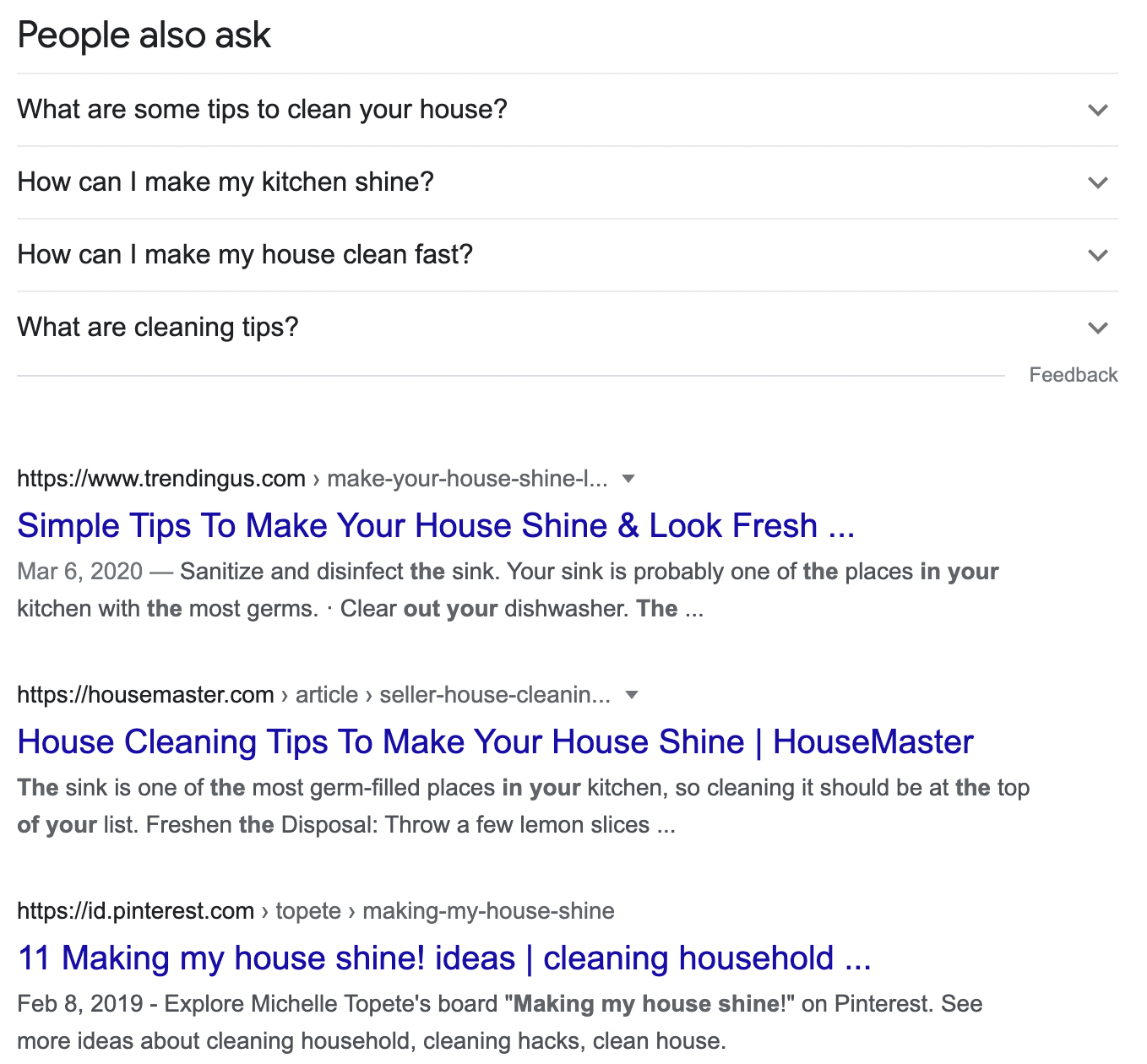
After the featured snippet, you can see a box of questions and answers related to the topic. This people also ask (PAA) section shows that Google is connecting this query with questions like "What are some tips to clean your house?" There's no product carousel or any other type of product-driven result. Positions 2, 3, and 4, are also taken by informational pieces. We can be sure this is informational intent.
How to optimize for informational intent: When it comes to content marketing, in-depth guides, a list of tips, checklists, and other kinds of educational content are generally the best fit for informational queries.
2. Navigational intent
A query has navigational intent when the goal of the search is to find a page from a specific source. For example, it's tough to look for a new app and not type "Zapier" alongside your query.
Of course, you don't want to rank for navigational queries meant for other websites because… what's the point? But you do want to keep track of whether or not you're ranking for your own company/brand name. This is strongly indicative of brand awareness and authority, which your marketing should be building toward.
For example, when typing "zogics" in my search bar, "zogics wipes" is the first recommendation to appear.

And of course, the SERP is filled with results from our domain.
You can recognize these queries because they all follow pretty much the same formula (or a slight variation of it): [product/service name] + [brand name], or vice versa.
How to optimize for navigational intent: Building a strong brand around a topic or niche is the best way to optimize your website for this type of search intent. You want your website to become a resource that people bookmark and continually visit, not just locate one time from a Google search.
3. Commercial intent
Commercial searches are about products or services people are interested in but aren't quite ready to purchase. Usually they include words and phrases like "best" or "which [product] should I buy?"
A lot of affiliate marketing sites focus on these queries. Terms like "what are the best wipes for my gym" and "how to choose the right dishwasher" are clearly commercial because the user is looking for information to make a purchase decision.

How to optimize for commercial intent: The content that frequently ranks well for these searches isn't the actual product listings. Instead, it's articles that review or compare different products.
4. Transactional intent
In most cases, users motivated by transactional search intent are ready to buy. They use combinations like:
Buy + [product name]
[product name] + price
[product name]
Discount + [product name]
Instead of lists of products or comparisons, you're more likely to find specific product pages.

4 ways to optimize your content for search intent
If you keep in mind these four search intents when planning and developing your content, you'll be able to offer information that's helpful for your readers when they need it—and that also means you're more likely to see an SEO boost.
1. Match the format of the content with the search intent
Before creating any page, I always think of the format that would be most helpful to the reader.
Sometimes this is intuitive: for example, for the query "how to sanitize hospital scrubs," creating a step-by-step guide would be a better fit than an eBook, right? But to be sure, you can analyze the search results for a given query, and you'll see patterns in the format of each result.
At Zogics, we created product guides to match commercial queries. These pages are meant to help the reader navigate through the consideration stage of their buyer's journey. Here's an example for you to check out: the cleaning station product guide.
2. Use the "people also ask" box in the outline phase
When dealing with informational queries, you can use the "people also ask" box to find common questions around the topic.
When we built the "PURTABS Disinfecting Tablets" page, we took a look at this box to find out which questions about the product we should address.
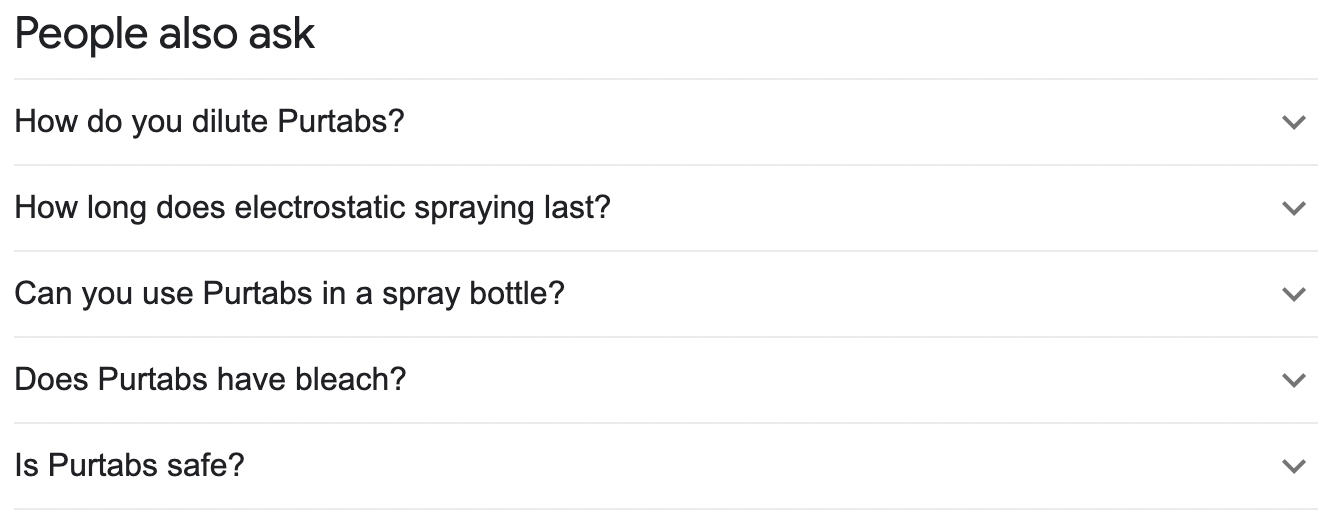
We also paid attention to the related searches.

With all that in mind, we developed a clear dilution chart (one of the related searches), since that's an easy way for readers to ingest information. We added facts about the tablets to ease our readers' minds on the safety and efficacy of the product (one of the people always ask questions), and we included an FAQ section at the bottom of the page to answer other specific questions.
3. Categorize your content ideas by search intent
Before doing extensive keyword research, take time to map your content ideas and categorize them by search intent. This will allow you to visualize how well distributed your content is. Are you only creating informational content? These are great pieces to attract traffic to your page, but in most cases, it will take a long time before they turn into customers. What commercial intent-driven pages could you create to support your sales team?
Having everything organized in one place (I suggest a spreadsheet!) will give you the big picture perspective. It will also give you a place to organize other aspects of your content, like the keywords and formats.
Here are the column headers I suggest you use in a search intent spreadsheet:
Keyword/topic
Search intent
Content format (listicle, in-depth guide, category/pillar page, checklist, tool, etc.)
Search volume
4. Optimize for passive intent as well
The active intent is the most explicit intent of the query. So if a user is looking for "tools to automate tasks," Google will prioritize listicles describing various automation tools. But if you read any of those articles, you'll also find tips and other resources for automation. This additional content is responding to a passive or secondary intent from the query—learning how to automate better.
We used a similar approach when creating our page on choosing a cleaning service for your business. We provided all the information the user needs to make a decision and then followed up with a cleaning service offering.
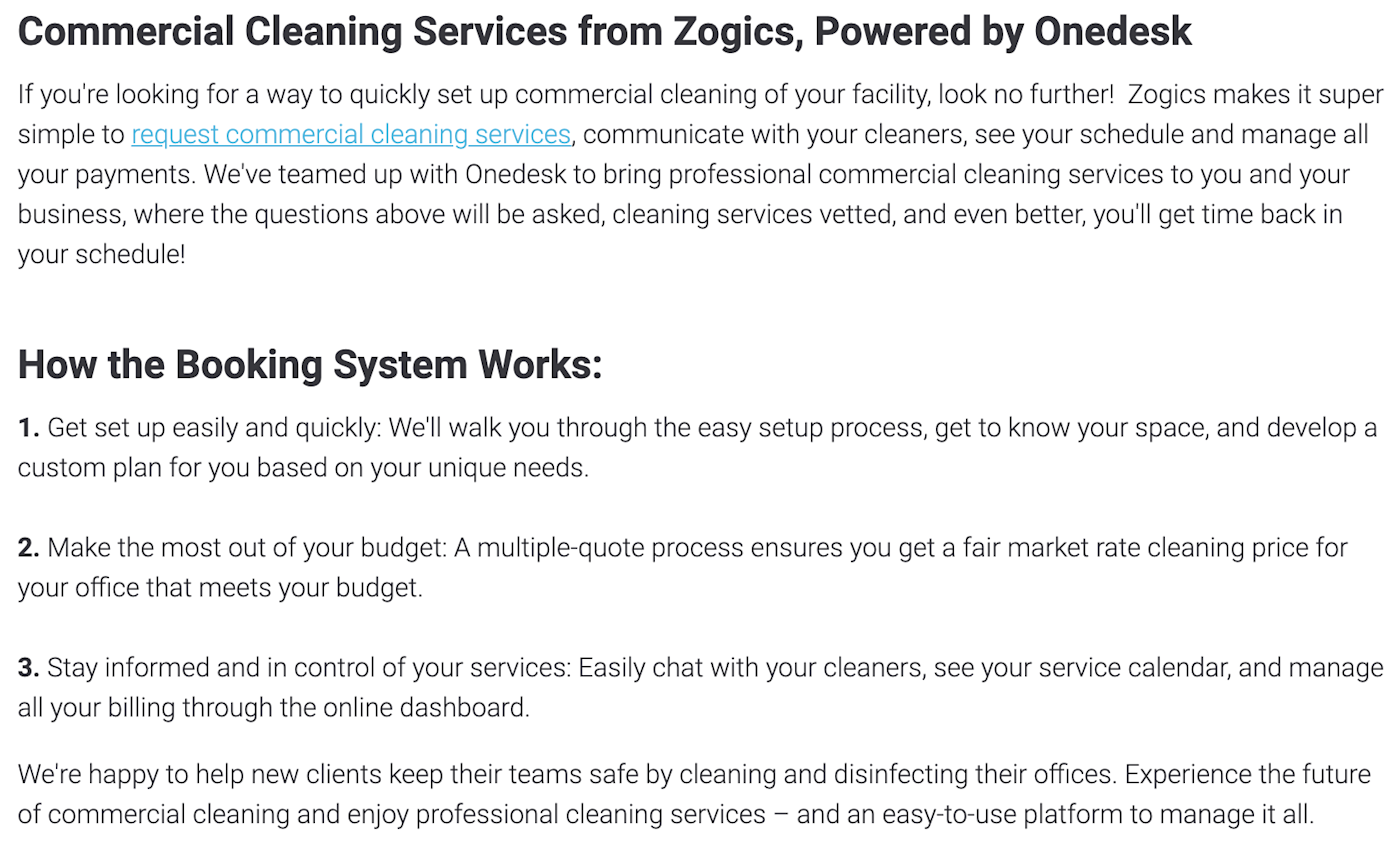
Why? Because if you're searching about how to choose a cleaning service, the logical next step—after you get the tips you wanted—is to hire a cleaning service.
Think about what other doubts the user might have and which other intention might be behind a search to add more context or solutions to your page.
Search intent isn't about short-term hacks or manipulating Google's algorithm to your benefit. Instead, it's about providing value to readers by making their job—searching for the information they need—easier.
Read more: The best SEO content optimization tools
This was a guest post from Jeff Stripp, Chief Revenue Officer at Zogics, a leading supplier of facility cleaning and disinfecting products to fitness, healthcare, hospitality, education, corporate, and transportation industries. Want to see your work on the Zapier blog? Read our guidelines, and get in touch.
